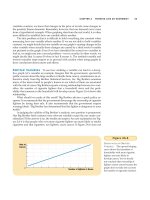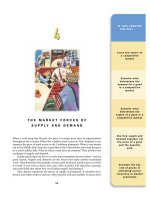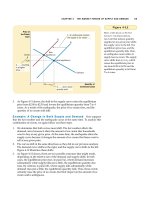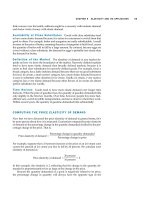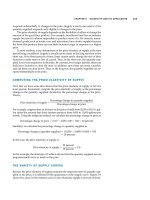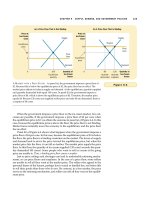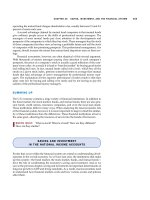Tài liệu Ten Principles of Economics - Part 19 docx
Bạn đang xem bản rút gọn của tài liệu. Xem và tải ngay bản đầy đủ của tài liệu tại đây (287.51 KB, 10 trang )
CHAPTER 9 APPLICATION: INTERNATIONAL TRADE 187
steel, a tax on steel imports is irrelevant. The tariff matters only if Isoland becomes
a steel importer. Concentrating their attention on this case, the economists com-
pare welfare with and without the tariff.
Figure 9-6 shows the Isolandian market for steel. Under free trade, the domes-
tic price equals the world price. A tariff raises the price of imported steel above the
world price by the amount of the tariff. Domestic suppliers of steel, who compete
with suppliers of imported steel, can now sell their steel for the world price plus
the amount of the tariff. Thus, the price of steel—both imported and domestic—
rises by the amount of the tariff and is, therefore, closer to the price that would
prevail without trade.
The change in price affects the behavior of domestic buyers and sellers. Be-
cause the tariff raises the price of steel, it reduces the domestic quantity demanded
from Q
1
D
to Q
2
D
and raises the domestic quantity supplied from Q
1
S
to Q
2
S
. Thus, the
tariff reduces the quantity of imports and moves the domestic market closer to its equilib-
rium without trade.
Now consider the gains and losses from the tariff. Because the tariff raises the
domestic price, domestic sellers are better off, and domestic buyers are worse off.
In addition, the government raises revenue. To measure these gains and losses, we
look at the changes in consumer surplus, producer surplus, and government rev-
enue. These changes are summarized in Table 9-3.
Before the tariff, the domestic price equals the world price. Consumer surplus,
the area between the demand curve and the world price, is area A ϩ B ϩ C ϩ D ϩ
E ϩ F. Producer surplus, the area between the supply curve and the world price,
is area G. Government revenue equals zero. Total surplus, the sum of consumer
surplus, producer surplus, and government revenue, is area A ϩ B ϩ C ϩ D ϩ E
ϩ F ϩ G.
O
UR STORY ABOUT THE STEEL INDUSTRY
and the debate over trade policy in
Isoland is just a parable. Or is it?
Clinton Warns U.S. Will
Fight Cheap Imports
B
Y
D
AVID
E. S
ANGER
President Clinton said for the first time
today that the United States would not
tolerate the “flooding of our markets”
with low-cost goods from Asia and Rus-
sia, particularly steel, that are threaten-
ing the jobs of American workers.
The President’s statement came
days after a White House meeting of top
executives of steel companies and the
United Steelworkers of America, which
helped get out the vote for Democrats
last week, playing a pivotal role with
other unions in the party’s success in
midterm elections.
After the meeting, which included
Mr. Clinton, Vice President Al Gore, and
top Cabinet officials, aides said the
White House would not grant the unions’
demand to cut off imports of steel they
say are being dumped in the American
markets. But today, the President
warned that foreign nations must “play
by the rules,” appearing to signal that
the United States would press other na-
tions to restrict their exports to the
United States. [
Author’s note:
In the
end, the Clinton administration did de-
cide to limit steel imports.]
S
OURCE
: The New York Times, November 11, 1998,
pA1.
IN THE NEWS
Life in Isoland
188 PART THREE SUPPLY AND DEMAND II: MARKETS AND WELFARE
Once the government imposes a tariff, the domestic price exceeds the world
price by the amount of the tariff. Consumer surplus is now area A ϩ B. Producer
surplus is area C ϩ G. Government revenue, which is the quantity of after-tariff
imports times the size of the tariff, is the area E. Thus, total surplus with the tariff
is area A ϩ B ϩ C ϩ E ϩ G.
To determine the total welfare effects of the tariff, we add the change in con-
sumer surplus (which is negative), the change in producer surplus (positive), and
the change in government revenue (positive). We find that total surplus in the
market decreases by the area D ϩ F. This fall in total surplus is called the dead-
weight loss of the tariff.
DEF
C
G
B
A
Price
of Steel
0
Quantity
of Steel
Domestic
supply
Domestic
demand
Price
with tariff
Tariff
Imports
without tariff
Equilibrium
without trade
Price
without tariff
World
price
Imports
with tariff
2
Q
S
1
Q
S
2
Q
D
1
Q
D
Figure 9-6
T
HE
E
FFECTS OF A
T
ARIFF
.A
tariff reduces the quantity of
imports and moves a market
closer to the equilibrium that
would exist without trade. Total
surplus falls by an amount equal
to area D ϩ F. These two triangles
represent the deadweight loss
from the tariff.
Table 9-3
B
EFORE
T
ARIFF
A
FTER
T
ARIFF
C
HANGE
Consumer Surplus A ϩ B ϩ C ϩ D ϩ E ϩ FAϩ B Ϫ(C ϩ D ϩ E ϩ F)
Producer Surplus G C ϩ G ϩC
Government Revenue None E ϩE
Total Surplus A ϩ B ϩ C ϩ D ϩ E ϩ F ϩ GAϩ B ϩ C ϩ E ϩ G Ϫ(D ϩ F)
C
HANGES IN
W
ELFARE FROM A
T
ARIFF
. The table compares economic welfare when
trade is unrestricted and when trade is restricted with a tariff. Letters refer to the regions
marked in Figure 9-6.
The area D ϩ F shows the fall in total surplus and represents the deadweight loss of the tariff.
CHAPTER 9 APPLICATION: INTERNATIONAL TRADE 189
It is not surprising that a tariff causes a deadweight loss, because a tariff is a
type of tax. Like any tax on the sale of a good, it distorts incentives and pushes the
allocation of scarce resources away from the optimum. In this case, we can identify
two effects. First, the tariff on steel raises the price of steel that domestic producers
can charge above the world price and, as a result, encourages them to increase pro-
duction of steel (from Q
1
S
to Q
2
S
). Second, the tariff raises the price that domestic
steel buyers have to pay and, therefore, encourages them to reduce consumption
of steel (from Q
1
D
to Q
2
D
). Area D represents the deadweight loss from the overpro-
duction of steel, and area F represents the deadweight loss from the undercon-
sumption. The total deadweight loss of the tariff is the sum of these two triangles.
THE EFFECTS OF AN IMPORT QUOTA
The Isolandian economists next consider the effects of an import quota—a limit on
the quantity of imports. In particular, imagine that the Isolandian government dis-
tributes a limited number of import licenses. Each license gives the license holder
the right to import 1 ton of steel into Isoland from abroad. The Isolandian econo-
mists want to compare welfare under a policy of free trade and welfare with the
addition of this import quota.
Figure 9-7 shows how an import quota affects the Isolandian market for steel.
Because the import quota prevents Isolandians from buying as much steel as they
want from abroad, the supply of steel is no longer perfectly elastic at the world
price. Instead, as long as the price of steel in Isoland is above the world price, the
license holders import as much as they are permitted, and the total supply of steel
in Isoland equals the domestic supply plus the quota amount. That is, the supply
curve above the world price is shifted to the right by exactly the amount of the
quota. (The supply curve below the world price does not shift because, in this case,
importing is not profitable for the license holders.)
The price of steel in Isoland adjusts to balance supply (domestic plus im-
ported) and demand. As the figure shows, the quota causes the price of steel to rise
above the world price. The domestic quantity demanded falls from Q
1
D
to Q
2
D
, and
the domestic quantity supplied rises from Q
1
S
to Q
2
S
. Not surprisingly, the import
quota reduces steel imports.
Now consider the gains and losses from the quota. Because the quota raises
the domestic price above the world price, domestic sellers are better off, and do-
mestic buyers are worse off. In addition, the license holders are better off because
they make a profit from buying at the world price and selling at the higher
domestic price. To measure these gains and losses, we look at the changes in
consumer surplus, producer surplus, and license-holder surplus, as shown in
Table 9-4.
Before the government imposes the quota, the domestic price equals the world
price. Consumer surplus, the area between the demand curve and the world price,
is area A ϩ B ϩ C ϩ D ϩ E' ϩ E''ϩ F. Producer surplus, the area between the sup-
ply curve and the world price, is area G. The surplus of license holders equals zero
because there are no licenses. Total surplus, the sum of consumer, producer, and
license-holder surplus, is area A ϩ B ϩ C ϩ D ϩ E' ϩ E'' ϩ F ϩ G.
After the government imposes the import quota and issues the licenses, the
domestic price exceeds the world price. Domestic consumers get surplus equal to
area A ϩ B, and domestic producers get surplus equal to area C ϩ G. The license
holders make a profit on each unit imported equal to the difference between the
import quota
a limit on the quantity of a good that
can be produced abroad and sold
domestically
190 PART THREE SUPPLY AND DEMAND II: MARKETS AND WELFARE
Isolandian price of steel and the world price. Their surplus equals this price dif-
ferential times the quantity of imports. Thus, it equals the area of the rectangle
E' ϩ E''. Total surplus with the quota is the area A ϩ B ϩ C ϩ E' ϩ E'' ϩ G.
To see how total welfare changes with the imposition of the quota, we add the
change in consumer surplus (which is negative), the change in producer surplus
(positive), and the change in license-holder surplus (positive). We find that total
surplus in the market decreases by the area D ϩ F. This area represents the dead-
weight loss of the import quota.
D
EЈ
EЉ
F
C
G
B
A
Price
of Steel
0
Quantity
of Steel
Domestic
supply
Domestic
supply
ϩ
Import supply
Domestic
demand
Isolandian
price with
quota
Imports
without quota
Equilibrium
with quota
Equilibrium
without trade
Quota
World
price
Price
without
quota
World
price
Imports
with quota
2
Q
S
1
Q
S
2
Q
D
1
Q
D
ϭ
Figure 9-7
T
HE
E
FFECTS OF AN
I
MPORT
Q
UOTA
. An import quota, like
a tariff, reduces the quantity of
imports and moves a market
closer to the equilibrium that
would exist without trade. Total
surplus falls by an amount equal
to area D ϩ F. These two triangles
represent the deadweight loss
from the quota. In addition, the
import quota transfers E' ϩ E'' to
whoever holds the import
licenses.
Table 9-4
B
EFORE
Q
UOTA
A
FTER
Q
UOTA
C
HANGE
Consumer Surplus A ϩ B ϩ C ϩ D ϩ E' ϩ E'' ϩ FAϩ B Ϫ(C ϩ D ϩ E' ϩ E'' ϩ F)
Producer Surplus G C ϩ G ϩC
License-Holder Surplus None E' ϩ E'' ϩ(E' ϩ E'')
Total Surplus A ϩ B ϩ C ϩ D ϩ E' ϩ E'' ϩ F ϩ GAϩ B ϩ C ϩ E' ϩ E'' ϩ G Ϫ(D ϩ F)
C
HANGES IN
W
ELFARE FROM AN
I
MPORT
Q
UOTA
. The table compares economic welfare
when trade is unrestricted and when trade is restricted with an import quota. Letters refer
to the regions marked in Figure 9-7.
The area D ϩ F shows the fall in total surplus and represents the deadweight loss of the quota.
CHAPTER 9 APPLICATION: INTERNATIONAL TRADE 191
This analysis should seem somewhat familiar. Indeed, if you compare the
analysis of import quotas in Figure 9-7 with the analysis of tariffs in Figure 9-6, you
will see that they are essentially identical. Both tariffs and import quotas raise the do-
mestic price of the good, reduce the welfare of domestic consumers, increase the welfare of
domestic producers, and cause deadweight losses. There is only one difference between
these two types of trade restriction: A tariff raises revenue for the government
(area E in Figure 9-6), whereas an import quota creates surplus for license holders
(area E' ϩ E'' in Figure 9-7).
Tariffs and import quotas can be made to look even more similar. Suppose that
the government tries to capture the license-holder surplus for itself by charging a
fee for the licenses. A license to sell 1 ton of steel is worth exactly the difference be-
tween the Isolandian price of steel and the world price, and the government can
set the license fee as high as this price differential. If the government does this, the
license fee for imports works exactly like a tariff: Consumer surplus, producer sur-
plus, and government revenue are exactly the same under the two policies.
In practice, however, countries that restrict trade with import quotas rarely do
so by selling the import licenses. For example, the U.S. government has at times
pressured Japan to “voluntarily” limit the sale of Japanese cars in the United
States. In this case, the Japanese government allocates the import licenses to Japan-
ese firms, and the surplus from these licenses (area E' ϩ E'') accrues to those firms.
This kind of import quota is, from the standpoint of U.S. welfare, strictly worse
than a U.S. tariff on imported cars. Both a tariff and an import quota raise prices,
restrict trade, and cause deadweight losses, but at least the tariff produces revenue
for the U.S. government rather than for Japanese auto companies.
Although in our analysis so far import quotas and tariffs appear to cause sim-
ilar deadweight losses, a quota can potentially cause an even larger deadweight
loss, depending on the mechanism used to allocate the import licenses. Suppose
that when Isoland imposes a quota, everyone understands that the licenses will go
to those who spend the most resources lobbying the Isolandian government. In
this case, there is an implicit license fee—the cost of lobbying. The revenues from
this fee, however, rather than being collected by the government, are spent on lob-
bying expenses. The deadweight losses from this type of quota include not only
the losses from overproduction (area D) and underconsumption (area F) but also
whatever part of the license-holder surplus (area E'ϩE'') is wasted on the cost of
lobbying.
THE LESSONS FOR TRADE POLICY
The team of Isolandian economists can now write to the new president:
Dear Madam President,
You asked us three questions about opening up trade. After much
hard work, we have the answers.
Question: If the government allowed Isolandians to import and export
steel, what would happen to the price of steel and the quantity of steel
sold in the domestic steel market?
Answer: Once trade is allowed, the Isolandian price of steel would be
driven to equal the price prevailing around the world.
